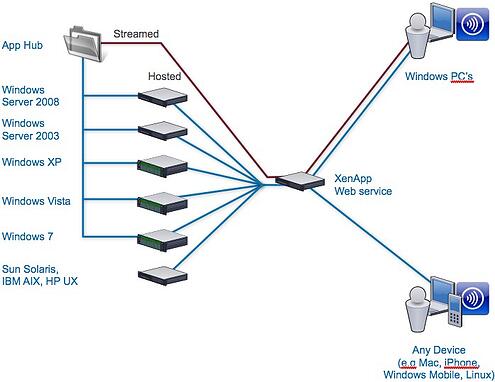In the second part of a 4-part series Better Virtualisation with Citrix —The challenges of application and desktop virtualization — we pointed out the common challenges of application virtualization such as supporting legacy applications, quickly responding to changing IT needs and ensuring protection against failures and disasters. In this part, we will examine some solutions to optimize system's hardware performance.
Better hardware utilization via higher consolidation ratios
While many physical XenApp servers already operate at high utilization rates and may not seem like good candidates for virtualization, several common scenarios exist in which IT organizations can achieve meaningful consolidation of their XenApp servers with XenServer. For example, due to limitations in the memory architecture in the 32-bit editions of Windows Server® 2003, 32-bit XenApp customers can quickly run into scalability barriers that govern user density on the server due to the Windows memory management architecture that constrains each application to its own virtual 4 GB memory space, which is evenly divided into two parts—2 GB of memory for kernel usage and 2 GB for application usage. Although each application gets its own 2 GB of memory, all applications must share the same 2 GB of application usage space. As users load a XenApp server, the total number of user sessions that the server can support is constrained by the shared kernel memory limits.

One opportunity for consolidation is to virtualize silos of 32-bit XenApp servers and consolidate them on 64-bit servers running XenServer. Consolidation of 32-bit servers on a 64-bit virtualization platform allows the XenApp administrator to break through the 4 GB memory barrier imposed by 32-bit platforms. 64-bit virtualization also allows XenApp servers to be scaled horizontally. In other words, by moving multiple instances of 32-bit XenApp VMs onto a single 64-bit server platform, XenApp customers can increase their XenApp user density per physical server, especially with new 64-bit x86 servers that come with 32, 64 or even 128 GB of RAM pre-installed. Finally, XenServer virtualization allows organizations that are not ready to migrate off their legacy 32-bit applications but wish to replace their outdated 32-bit servers to leverage the capacity of 64-bit servers without an expensive and complex upgrade for the underlying applications.
Similarly, many XenApp customers discover that they can consolidate underutilized XenApp support and infrastructure servers, such as the licensing server, SmartAuditor server or Web Interface, allowing the XenApp administrator to achieve consolidation without impacting user experience or application performance.
Virtualization with XenServer allows XenApp administrators to isolate and consolidate rarely utilized application silos as unique VMs running on a single host server, and consolidate XenApp server farms. The resulting savings in power, cooling and real estate can be significant. Since much of the cost associated with operating a server is due to power and cooling consumption, organizations can now green their IT operations and ultimately consume fewer natural resources. Such green IT initiatives allow businesses to significantly reduce costs through lower utility bills, adopt environmentally progressive social responsibility programs and, in some jurisdictions, benefit from government tax incentives.
Simplified management
Since XenServer is a bare-metal hypervisor, multiple VMs can run on a single physical server without a heavyweight operating system. This bare-metal approach means that there is no underlying host operating system to manage and that the VMs are entirely portable and can be managed entirely within the easy-to-use and lightweight XenCenter management console. With this console, VMs can be started, stopped, moved, created, copied and backed up—all with a couple of mouse clicks.
In addition, the premium editions of XenServer make it possible to achieve greater flexibility in XenApp or XenDesktop deployments by allowing OSs and applications contained in the VMs to be streamed to either the physical or virtual infrastructure from a single virtual disk or golden image using provisioning services. These capabilities make it easier to maintain, manage, update and patch the application stack as well as ensure a consistent process regardless of whether physical or virtual infrastructure is utilized. As a result, both XenApp and XenDesktop workloads can be delivered on demand rather than be physically installed on top of individual servers. XenServer allows an administrator to create a virtual image of any XenApp or XenDesktop workload to be streamed from network storage to either physical or virtual servers. These target servers do not need internal storage and can be bootstrapped from a single workload image stored on the network. In some scenarios, up to 1,000 desktops can be booted from the same golden image, dramatically reducing storage usage and a significant expense in large XenDesktop deployments.
The use of provisioning services also allows IT staff to rapidly scale up to meet application demands and scale down when demand diminishes. Consider a scenario in which increases in seasonal staff put pressure on IT staff to scale out XenApp application delivery capacity. XenServer can help provision new XenApp or XenDesktop workloads nearly instantaneously to meet demand.
XenServer also helps automate, manage and control test and development processes for XenApp workloads or XenDesktop deployments, providing greater flexibility. This flexibility and control is delivered via Lab and Stage Manager in XenServer Platinum Edition. The lab and stage functions help the IT organization speed development and testing of applications or desktop builds. These functions coordinate the movement of a VM from the development to test to QA to production environments and keep the test environment in sync with the production environment. As a result, IT can share resources across each stage of the cycle, and production environments are armed with the most recent, reliable and fully tested desktop or application builds.
Source: Citrix's Blog
Look for our next edition of the Better Virtualisation with Citrix series on "Addressing the challenges of application and desktop virtualization" (part 2). Thank you for reading and look forward to your comments. Visit our website to find out more about Citrix Virtualisation Solutions.
Subscribe to our blogs to get great content delivered straight to your inbox!
 English
English  Vietnamese
Vietnamese 

